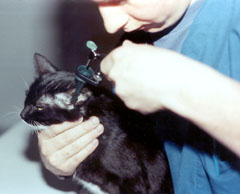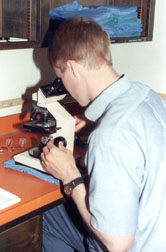
| This picture shows an otoscopic exam being performed on a cat. |
Introduction:
Infections of the ears can occur at any age and affect the ears of any type of cat. Hair tends to impede the normal removal of debris and wax from the ear canal and can be a major initiating cause for an ear infection.Causative Agents: Ear infections may be caused by bacteria, yeasts, mites, fleas, or ticks. Irritation of the ear canal by foreign material, such as grass or foxtails, can also produce ear infections by creating an environment in which these causative agents can flourish. Other conditions which commonly make a cat prone to ear infections include excess moisture, allergies, dry scaly skin, and ear polyps or tumors, or a combination of any of the above. Small numbers of bacteria and yeast can be found in normal ears.
Clinical Signs: At first, the animal may occasionally scratch at the ear or shake the head. As the problem progresses, the scratching and shaking become more intense. Sometimes dark debris, blood, or a foul odor is noticed. In some cats, a complication which is often noticed by the owner is a swelling of the pinna or "moveable part" of the ear. This swelling is called an aural hematoma and is usually self-inflicted by shaking the head or scratching the ear. The swollen area in the pinna is usually hot to the touch and extremely painful. If an ear infection continues untreated, swelling of the inflamed tissues will cause the ear canal to narrow and further impede the outward movement of debris. Scar tissue will often replace the normal lining of the ear canal and may block the ear completely. Once this occurs, permanent hearing loss is common. The infection may spread to other structures and cause problems with the nerves of the face, balance problems, and pain when opening the mouth.
Disease Transmission: Ear infections are not usually regarded as contagious from one animal to another; however, drainage from a severely infected ear may be teeming with bacteria or other infectious agents. Any cut or open wound, inflamed tissue, or exposed mucosal surface such as the mouth or eye, can easily become infected if exposed to such infection-laden material.
Diagnosis: The diagnosis of an ear infection is relatively simple. The first step in diagnosing this problem is accomplished by visual inspection of the ear canal. An instrument known as an otoscope is generally used for this purpose. The otoscope is inserted in the ear canal and the canal is held open while a light illuminates the area (see Fig. 1). Some cats will not tolerate this procedure while awake and may require sedation. If the ear canal is free of foreign objects or large amounts of debris, the veterinarian can assess any damage done to the ear drum located at the very end of the canal. Ticks, especially if engorged with blood, should be large enough to be seen and removed during the otoscopic examination. The next diagnostic step is to determine if an infection is present by taking a sample of any discharge and staining the sample on a glass microscope slide. This test is known as an ear cytology. Yeasts, bacteria, and mites may be seen by microscopic examination (see Fig. 2). Some bacterial infections may need to be cultured in order to be successfully identified and treated.
Figure 1
|
|
Figure 2

|
|
Treatment: Treatment should address both the infection itself and the underlying cause (excess moisture, allergies, dry scaly skin, ear polyps or tumors). Therapy for the infection itself may involve flushing the ear while the cat is under anesthesia and/or administering antibiotics, anti-fungals, anti-parasitic drugs, and anti-inflammatory drugs. Specific therapy for infections should be based on ear cytology and/or culture. Certain ear medications should not be used if the ear drum is damaged; hence, the importance of the otoscopic examination. See page B180 for additional information on ear care. Aural hematomas require specific surgical treatment to drain the swelling, followed by placement of sutures (stitches) or special bandages to prevent recurrence.
Therapy for underlying causes (excess moisture, allergies, dry scaly skin, ear polyps or tumors) may involve regularly flushing the ear or administering certain medications. If a foreign object or small tumor is present, it should be removed and the infection may then be treated. However, if the underlying cause is a more involved condition such as an allergy, successful treatment of the ear infection will rely greatly on the proper diagnosis and treatment of that condition.
Prevention:
Good grooming, proper diet, and careful observation of a pet can help prevent this problem or at least catch it in the early stages. If a problem is suspected, an examination by a veterinarian and subsequent therapy can help prevent a potentially serious and damaging situation.